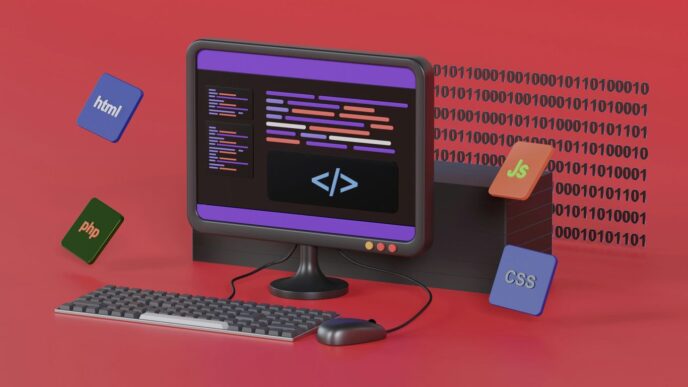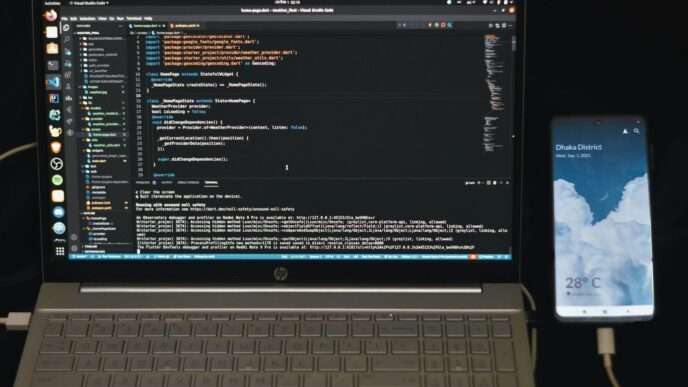Writing a sample networking email can feel awkward, especially if you’re reaching out to someone you don’t know well. You want your message to stand out, not get buried in their inbox with all the other requests. The trick is to keep things simple, clear, and personal. If you’re hoping to get a real response, it’s all about showing you’ve done your homework and making it easy for them to reply. Here’s how you can craft a sample networking email that actually gets noticed—and answered.
Key Takeaways
- Always have a clear reason for reaching out before you write your sample networking email.
- Start with a subject line that catches attention but doesn’t sound spammy.
- Personalize your message—mention something specific about the person or their work.
- Keep your email short and to the point, so it’s easy to read on any device.
- End with a simple, polite question or next step that makes it easy for them to reply.
Understanding the Purpose of a Networking Email
Sending a networking email isn’t just about asking for favors or making random introductions. At its core, a good networking email is about starting a conversation that could benefit both you and the recipient. If you approach it from the right angle, it opens doors, builds genuine connections, and leaves a lasting impression. Here’s what you need to know to get started.
Defining Your Objective Clearly
Think about what you actually want to achieve before typing a single word. Ask yourself:
- Am I seeking advice, job information, mentorship, or something else?
- Is my goal realistic for a cold email?
- How will the recipient benefit from helping me?
Writing down your main goal (even as a bullet point for yourself) will help keep your email focused. Too many messages get ignored simply because there’s no clear ask or the reason for reaching out feels muddy.
Knowing Your Audience and Their Needs
It’s tempting to blast the same email to a bunch of people. Don’t. A thoughtful message sent to the right person is always more effective than a generic, copy-paste job. Start by researching the recipient:
- What is their role, and what are they known for?
- What recent projects or achievements have they been involved in?
- Are there any shared interests, connections, or backgrounds?
This background work shows you respect their time and are genuinely interested, not just phishing for contacts. Even busy professionals appreciate when someone’s clearly done their homework, especially given how email is still the backbone of most professional communication (enables convenient communication).
Aligning Your Goal With the Recipient’s Interests
If your ask lines up with something the recipient cares about, your chances of getting a response jump way up. Here are a few simple ways to do this:
- Mention any mutual connections or shared interests up front.
- Tie your request to their recent work or expertise.
- Explain what you admire about their background or career.
It helps to view the process as a two-way street. Even if you’re the one asking for something, making it relevant to them shows you respect their perspective and aren’t just looking for a handout.
In short, sending a standout networking email means knowing exactly why you’re reaching out, understanding who you’re writing to, and showing how your interests or goals align.
Key Elements of an Effective Sample Networking Email

Building a networking email that doesn’t get lost in the shuffle can be tricky. You don’t have tons of space or time to work with, so each part of your message has to matter. Let’s talk about what separates a forgettable email from one people actually want to respond to.
Crafting an Engaging Subject Line
Your subject line is the first thing anyone sees—so it needs to grab attention without trying too hard. Imagine your inbox on a busy Monday morning; would you open a message with the subject “Quick Question,” or “Loved Your Recent Blog Post—Quick Chat?” The difference is clear. To write a solid subject line:
- Make it specific: Reference a shared connection, recent project, or industry topic.
- Keep it short: Aim for 5–7 words or about 40 characters.
- Avoid spammy words like "Free" or "Urgent."
Here’s a quick comparison table:
| Boring Subject Line | Engaging Subject Line |
|---|---|
| Quick Question | Inspired By Your Podcast Talk |
| Networking Request | Follow-up on Marketing Meetup |
| Hello | Coffee? Learn About [Their Project] |
Personalizing Your Opening Line
The first line is where most readers decide if they’ll keep going. "Hope this email finds you well" is the easiest way to get ignored. Instead, try mentioning something specific about the person:
- Point out an article they wrote, or their company’s recent achievement.
- Mention that you share a mutual contact.
- Tie your introduction to a detail from their work or public profile.
This doesn’t need to be long—just a quick sentence that says, “I know who you are, and I’m not emailing everyone in your city.”
Keeping Your Message Clear and Concise
Nobody wants a wall of text. Say what you want, and say it fast. The sweet spot seems to be:
- 2–3 sentences about why you’re reaching out and what caught your interest.
- 1–2 sentences explaining how the other person might benefit, or why you think the connection makes sense.
- An easy, friendly question or request—for example, “Would you be open to a quick call next week?”
A clear, brief message respects the recipient’s time and increases your odds of a reply. Write like you talk, skip the fancy stuff, and get to the point.
If you want more specifics on how to structure a professional email—including tips on subjects and formatting—take a look at these core professional email guidelines.
Making each part of your email matter isn’t about showing off. It’s about making it simple for someone to say yes to a conversation. If you get these basics right, you’re already ahead of most people pressing send today.
Personalization Strategies to Increase Response Rates
Making your networking email feel personal is the real game changer for getting replies. People aren’t going to engage with generic pitches anymore—they expect messages that show you understand who they are. Here are some focused tactics to make your email impossible to ignore.
Referencing Mutual Connections or Shared Interests
Starting with a shared point, like a mutual contact or a specific experience, creates instant familiarity. Don’t just say, "We both know Sarah"—try mentioning a detail about how you worked together.
- Identify a real shared connection or group (university alumni, previous colleagues, membership in the same organization).
- Bring up a shared hobby, book, or event ("I saw you led a session at the Growth Summit—loved your take on marketing experiments").
- Be honest—don’t manufacture a connection just for the email. Faking this comes across as insincere.
A quick example: “I noticed we both worked with Taylor on the 2022 community project. Her ability to keep everyone motivated was inspiring—I’d love to hear about your experience.”
Highlighting Specific Achievements or Projects
People respond well when it’s clear you’ve done your research. Mention a particular project, award, or article the recipient worked on. This turns your email from a cold request into a conversation.
Here are steps for doing this right:
- Check LinkedIn profiles, company sites, or recent press releases.
- Bring up a specific result or milestone (“I saw your team just rolled out the updated app feature last month—it’s made a real impact for users like me”).
- Avoid vague compliments like "You seem innovative." Get specific.
When you put thought into your message, people see you’ve invested time before hitting send. This attention can set your email above all the rest, as proven in direct mail campaign strategies where tailored messages increase response rates.
Tailoring Content to the Recipient’s Industry
Sending a one-size-fits-all message rarely works. If they’re in healthcare, talk about trends or pain points there. For someone in finance, relate to the latest regulations or tools.
Quick checklist for industry relevance:
- Use correct industry language, but skip heavy jargon.
- Reference current market challenges (“I read about the shift in patient data privacy rules affecting your sector—curious about your perspective”).
- Attach or reference resources tailored to their work world (relevant reports, podcasts, or webinars).
| Industry | Common Hot Topic | Example Reference in Email |
|---|---|---|
| Tech | Software adoption | "I saw your review on the new CRM—did it speed things up?" |
| Marketing | Attribution models | "Your post on multi-touch attribution inspired me to test new approaches." |
| Healthcare | Data privacy laws | "With new HIPAA changes, how are you keeping data compliance easy?" |
If you combine all these, your email stands out as thoughtful—not just another ask. These strategies don’t guarantee every message will get a reply, but they boost your odds. Make it about them, not just about what you want.
Structuring Your Message for Maximum Impact
Getting someone to open your email is hard enough. Getting them to reply? That’s a whole different challenge. The way you lay out your message can make all the difference. An email that flows well, starts strong, gives clear value, and ends with an unmistakable request is much more likely to get you that reply you want. Let’s break down how to do that, step by step.
Opening With a Strong Hook
You have about three seconds to catch someone’s attention. Skip the usual openings like "I hope you’re well" or "I’m reaching out because…" They’re so common, folks tune them out. Instead, try these tactics:
- Start with a specific mention: “I saw your LinkedIn post about creative hiring strategies—loved your tips.”
- Reference a recent achievement: "Congrats on the product launch—looks like it’s gaining real traction."
- Lead with a question: “Curious—how do you decide which marketing channels to double down on?"
The opening line sets the tone and shows that you actually paid attention to the recipient’s work or interests. This is where you stand out from dozens of bland emails clogging up their inbox.
Explaining the Value Proposition
Once you’ve got their attention, don’t waste it. You have to answer the silent question every reader has: What’s in it for me?
Here’s how you can do it:
- Be direct—get to your point in one or two sentences.
- Tie your solution or idea to a specific need or goal of theirs.
- Give proof if you can, like a client result or a short story.
Example table of quick-value props:
| Value Statement | What It Means |
|---|---|
| "Boosted sales by 30%" | Shows clear results |
| "Saved 10 hours/week" | Connects to time savings |
| "Helped launch in 2 weeks" | Short timeline, moves fast |
A focused value prop shows you’ve done your homework. It answers "Why are you emailing me, specifically?" without making them scroll.
Concluding With a Clear and Polite Call to Action
You’ve piqued their interest and explained your value—now, don’t leave them hanging. Your closing should be clear, polite, and as easy as possible to respond to.
Some ways to finish strong:
- Ask a clear question ("Would you be open to a short call next week?")
- Give them two options for times to meet—makes it quicker to reply.
- Offer something useful, like a resource or intro ("Happy to share a quick guide if you’re interested.")
Tips for effective calls to action:
- Keep the CTA to one sentence.
- Make the next step obvious—no guessing.
- Avoid sounding pushy.
A clear request makes it simple for your recipient to respond—whether it’s yes, no, or "maybe later".
When your email opens with a hook, follows up with crisp, relevant value, and ends with a clear, friendly ask, you’re way more likely to get a real answer—not just radio silence. Try these steps, tweak as needed, and you’ll see your response rate climb.
Best Practices for Follow-Up and Timing
Staying on top of your networking emails means more than just sending one message and hoping for the best. Following up—at the right time and in the right way—can make the difference between getting a response and getting ignored.
Timing Your Initial Email and Follow-Up
Timing really does matter when you’re trying to get someone’s attention through email. The trick is to send your initial message when people are most likely to check their inbox. Want to know when that is? Here’s a simple, helpful table:
| Day | Recommended Send Time | Why |
|---|---|---|
| Tuesday | 9–11 am | Most people have cleared Monday’s chaos |
| Wednesday | 9–11 am | Midweek focus and less inbox clutter |
| Thursday | 9–11 am | People still engaged before week wraps |
When it comes to your follow-up, waiting about a week is smart. It gives the recipient enough time to see your message without feeling hassled. If there’s still no reply, a second (and final) follow-up after another week is fair. Anything more starts to feel like pestering.
Writing a Polite and Effective Follow-Up Message
Keep these points in mind for a solid follow-up:
- Make it quick—no one wants to read a novel in their inbox
- Reference your previous email so the recipient has context
- Add something useful or relevant, like a link to a resource, a short update, or a bit of news that ties into your last note
For more tips on keeping your follow-ups friendly and efficient, check out these ways to write effective follow-up emails.
Recognizing When to Move On
There’s a point where persistence turns into nagging—and you don’t want to be remembered for that. Here’s a guide for knowing when to stop:
- If you’ve sent your initial message and two follow-ups with no answer, it’s time to let it go.
- Sometimes, no response really just means "not interested" or "too busy"—don’t take it personally.
- Put the contact on a separate list for periodic check-ins (maybe every six months), or just move on to others in your network.
Most people get busy or overwhelmed, so silence is rarely about you specifically. Staying professional, brief, and polite—throughout the process—leaves the door open for a better response next time.
Common Mistakes to Avoid in a Sample Networking Email
Sending networking emails can feel nerve-wracking, and sometimes, people fall into the same traps over and over. If you want your message to actually get read and not just skipped over, it’s helpful to know what not to do. Here are some frequent mistakes you’ll want to sidestep:
Using Generic or Vague Language
Nobody likes getting a message that feels cut-and-paste or could have been sent to anyone. Saying things like “To whom it may concern” or “I’m reaching out for networking purposes” shows no effort at all. Instead, make it clear you’ve done your homework. Show you know who you’re writing to and why they matter.
Bullet points for spotting generic messages:
- Starts with a bland opener like "Hi Sir/Madam" or “Dear Hiring Manager.”
- No mention of anything unique about the recipient or their work.
- Entire message could be swapped out with another contact’s name and no one would notice.
In fact, just reusing old templates can leave weird formatting behind, making you look careless. Taking a few minutes to write something just for them almost always pays off, as even a short personal touch stands out.
Being Overly Formal or Too Casual
Striking the right balance with your tone is harder than it seems. Go too formal, and you sound stiff: too casual, and you risk being seen as unprofessional. “Dear Sir or Madam” brings back grade-school vibes, while “Heyyyy, what’s up?” isn’t likely to get a response in most industries.
Here’s a tip: start friendly, not stuffy. Use their first name unless you know they prefer a title. Sound like yourself, not a robot, but remember you’re talking business.
Requesting Too Much Too Soon
This might be the biggest tripwire. If your first request is for a major favor—like a job referral or an hour-long meeting—you might not get a reply. People get lots of these emails, and the ones that ask for a quick chat or a simple point of advice have a much better shot.
Simple do’s and don’ts:
- Don’t launch straight into big asks or projects.
- Don’t assume your recipient has tons of free time.
- Do consider what’s easy for them to do—maybe replying with a quick answer, rather than a detailed favor.
Quick Table: What Not to Ask in Your First Email
| Good First Ask | Bad First Ask |
|---|---|
| “Could you share a tip?” | “Will you mentor me?” |
| “May I ask one question?” | “Can you refer me for a job?” |
| “Could you recommend a book?” | “Let’s meet for coffee?” |
Cards on the table—a little research and patience goes a long way. Whether you’re new to email networking or just want to be sure you’re not being ignored, avoiding these mistakes can get your foot in the door a lot faster. And, if you’re looking to connect using other channels, social platforms have their own set of best practices. Building a strong social media presence can make your networking even more effective.
Templates and Real-World Examples of Standout Networking Emails
Making your networking outreach stand out often comes down to how you structure your email. Just copying and pasting a bland template probably won’t get you far. The trick is knowing when to stick to a structure, when to make your message specific, and when to let your natural voice shine through. Let’s look at a few sample networking email templates and real-life examples that actually work.
Sample Email for Seeking Advice or Insights
When you want advice, don’t come across as a time-drain. Get to the point and show appreciation for the recipient’s work. Here’s a basic template you can use:
Subject: Quick Advice Request from an Aspiring [Recipient’s Profession]
Hi [Recipient’s Name],
I’m [Your Name], and I’ve been following your career since your project with [Noteworthy Company/Project]. I’m currently at [Your Company/School], hoping to transition into [Industry/Field], and your recent work has been inspiring. If you have five minutes, I’d love any advice you might share about breaking in or resources you’d recommend.
Thanks so much for your time,
[Your Name]
Why it works:
- Short, respectful of the recipient’s time
- References a specific achievement
- Clear on what you’re asking for
Sample Template for Job or Partnership Inquiries
Sometimes you want to be direct without feeling pushy. Adapt the approach if you’re trying to connect for jobs or partnerships:
Subject: Exploring Collaboration Opportunities at [Company Name]
Hi [Name],
I noticed your team at [Company] recently launched [Project/Initiative], and the results caught my eye. At [Your Company/Role], I’ve worked on similar projects like [Quick Example]. I’d love to chat about ways my background might support your goals, or future roles that could be a fit. Would a short call work this week?
Thanks for considering,
[Your Name]
Key features here:
- Quickly shows knowledge of the company
- Highlights related experience
- Offers a call, not just a resume or a LinkedIn request
If you want more variety, there are collections of proven sales email templates that go beyond job or networking messages and have been tested for better response rates.
Creative Approaches That Have Proven Response Rates
Getting creative doesn’t have to mean wild formatting or emojis. Sometimes, it’s about tone and timing. Here are three creative approaches:
- Mutual Connection Reference: Open by mentioning a person you both know or a conference you both attended in the past month. It makes your email less random.
- Compliment with Context: Instead of “I admire your work,” mention a specific article, podcast, or project. Example: "Your piece on remote work culture last fall hit home for me, especially the section about process automation."
- Short and Sweet: Some folks are flooded with email, so a message like, "Hi [Name], saw your recent post on [Platform]. Curious if you’re open to a quick chat about [specific topic]?" can cut through the noise.
Real-world tip:
- The best responses often come from genuine observations and a simple ask, not heavy flattery or desperate language.
Summary Table: Common Networking Email Types and Their Typical Response Rates
| Email Type | Typical Response Rate |
|---|---|
| Personalized Advice Request | 20-30% |
| Job/Partnership Inquiry | 15-25% |
| Creative/Short Approach | 25-35% |
Remember, the key is making it sound like you, not a robot or a generic message factory. Polished is nice, but human and specific is better. Try different approaches, and don’t stress if every message doesn’t get a reply—sometimes, it’s just about timing.
Conclusion
So, that’s pretty much it. Writing a networking email that actually gets a reply isn’t about using fancy words or stuffing in every detail about yourself. It’s about being real, keeping things short, and showing the other person you actually care about connecting—not just getting something from them. Try out different approaches, see what feels natural, and don’t be afraid to tweak your message if you don’t get a response the first time. Most people are busy, so a little bit of effort to personalize your email goes a long way. At the end of the day, the best emails are the ones that sound like you, not a robot. Good luck, and happy networking!
Frequently Asked Questions
What makes a networking email stand out?
A standout networking email is short, clear, and personal. It shows you know something about the person you’re writing to and explains why you’re reaching out. Adding a specific detail, like a shared interest or recent achievement, helps your message feel unique and not like a copy-paste.
How long should my networking email be?
Keep your email short—usually between 100 and 200 words. Busy people don’t have time to read long messages, so make your point quickly and keep it easy to read.
What should I put in the subject line?
Your subject line should be friendly and clear. Try to mention something specific, like a mutual connection or a topic you both care about. For example, ‘Quick Question About Your Recent Project’ or ‘Connecting Through [Mutual Contact]’.
How soon should I follow up if I don’t get a reply?
If you don’t hear back in about a week, it’s okay to send a polite follow-up. Just remind them of your first message and ask if they had a chance to read it. If there’s still no answer after a second follow-up, it might be best to move on.
Should I use a formal or casual tone?
Aim for a tone that is friendly but respectful. You don’t need to be super formal, but don’t be too casual either. Match your language to how the person usually communicates, especially if you’ve seen their posts or emails before.
What are common mistakes to avoid in networking emails?
Don’t send the same generic message to everyone. Avoid asking for too much right away, like a job or a big favor. Also, don’t forget to check for spelling mistakes and make sure your email makes sense. Personalizing your message and being polite goes a long way.














